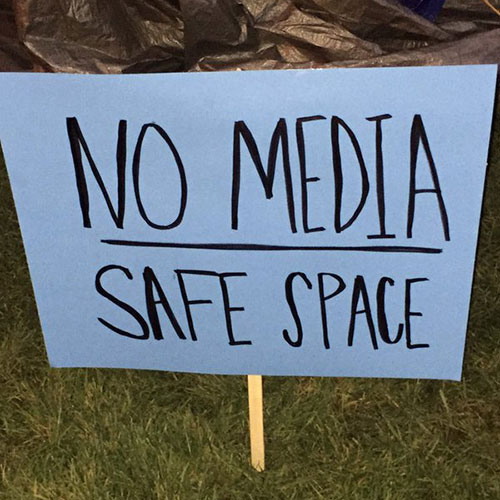The University of Missouri employees who interfered with newsgathering at a public protest on Monday have come in for widespread criticism from members of the press. But they have also done the student body of university a great disservice in modeling how to start a revolution—or, for that matter, simply deal with the media to advance their own cause.
As seasoned journalists, we cringed when we saw an administrator lock arms with students to push a photographer backward, and a communications professor call for “some muscle over here” to eject a student videographer filming at Carnahan Quadrangle. These employees should have respected the rights of journalists, of course. (Both have since apologized.)
But had they really wanted to support the student activists, they could have sought instead to coach students in strategies for engagement with the media. Where were democratically chosen student representatives armed with talking points for reforms to the campus racial climate? What’s the consistent narrative these students sought to communicate at this assembly?
How to engage the media, even use and manipulate it, are real tools these students could deploy to effectively tell their story. Instead, this video depicts earnest students with legitimate issues articulating a consistent misunderstanding of basic tenets of American civic engagement. “You’d better back up,” one male student said to Tim Tai, a young journalist trying to take photographs on the quad. “Forget the law, what about humanity?” a young woman responded to Tai’s calm First Amendment explanation of his right to be there. Another male student suggested the police could come take Tai away, which is patently not true.
The coalition of student activists standing up for justice on campus—and interfering with the rights of journalists to cover the protests—was multicultural and multiracial. But as African-American journalists ourselves, we hate that so many of the untruths uttered at Tai came from black students. And we fear that the ethos of “No Media—Safe Space” is both an obstacle to their current goals and something that will stay with them when they go home to run the world.
There are reasons for student activists, and African-American students in particular, to be suspicious of the media. If they’re living in a small market, it’s unlikely they’ve dealt with news outlets that reflect racial diversity, which skews coverage. Even in large cities, good luck getting outlets to do more than swoop in for spot coverage of tragedies and surface reporting in minority communities. Consider the difference between how current discussions of the heroin epidemic reflect white humanity versus the way drug use has long been covered in African-American communities.
We know of journalists who won’t cross the color lines of their respective towns to get to know the people they cover. So we can understand the cynicism students feel about traditional media that does not look like many of them, and does not tell nuanced stories on a local or national level that reflect their existence. And with the emergence of social media platforms, we can understand why student activists and their allies may feel they do not need to engage with journalists to get their message out. “Everybody has documented it,” a university administrator tells Tai when he tries to explain his role.
But to truly demonstrate self-determination, activists would do well to also learn how to use the media to amplify their story, even as, in the telling and retelling, they maintain ownership.
Journalists need to do better. But these students need a model for cultivating relationships with journalists in hopes of communicating desperately needed nuance, especially in the stories of underserved groups like minorities and women.
For that matter, what a horrible lesson to teach young people of any race and ethnicity to shrink from the spotlight because they can’t control how their righteous cause will be viewed—just that it will be viewed, period. There is power in stepping into that spotlight. If you’re going to protest, be prepared for coverage, and prepared to tell and protect your story.
Fortunately, there are already signs of a change of heart on campus. There were reports yesterday of leading student organizers reminding protestors of the media’s First Amendment rights—and also the role the media can play in bringing their stories to the world. “We’re learning as we go along,” said Reuben Faloughi, one of those organizers. “We have to follow the law … we’re students. We’re learning.” On such a fast learning curve, these students are fixing what doesn’t work in real-time.
Deborah Douglas and Afi-Odelia Scruggs are, respectively, a senior facilitator at The OpEd Project and adjunct lecturer at Northwestern University, and a digital storyteller and a former columnist for the Cleveland Plain Dealer.

